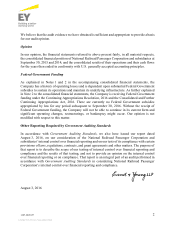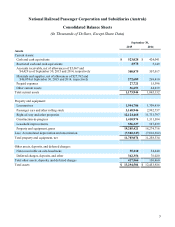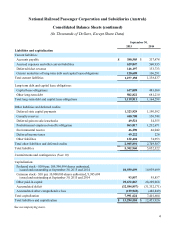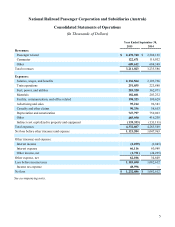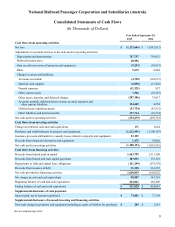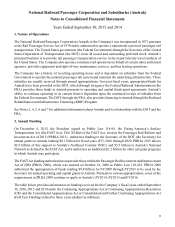Amtrak 2015 Annual Report Download - page 14
Download and view the complete annual report
Please find page 14 of the 2015 Amtrak annual report below. You can navigate through the pages in the report by either clicking on the pages listed below, or by using the keyword search tool below to find specific information within the annual report.National Railroad Passenger Corporation and Subsidiaries (Amtrak)
Notes to Consolidated Financial Statements (continued)
3. Basis of Presentation and Summary of Significant Accounting Policies (continued)
12
of September 30, 2015 and September 30, 2014 primarily consists of funds restricted for certain operations
of the Amtrak Police Department.
Accounts Receivable and Allowance for Doubtful Accounts
Accounts receivable in the Consolidated Balance Sheets include billed and unbilled accounts receivable.
Billed accounts receivable represent amounts for which invoices have been sent to customers. These accounts
receivable are recorded at the invoiced amount and do not bear interest. Unbilled accounts receivable represent
amounts recognized as revenue for which invoices have not yet been sent to customers but for which services
and work have been done. The Company recorded $121.1 million and $102.3 million of unbilled accounts
receivable as of September 30, 2015 and 2014, respectively.
The allowance for doubtful accounts is the Company’s best estimate of the amount of probable credit losses
in the Company’s billed accounts receivable. To determine its allowance for doubtful accounts, the Company
evaluates historical loss experience and the characteristics of current accounts, as well as general economic
conditions and trends. Uncollectible billed accounts receivables are charged against the allowance.
Materials and Supplies
Materials and supplies, which are stated at weighted-average cost, net of allowance for shrinkage and
obsolescence, consist primarily of items for repairs and maintenance of property and equipment. The
allowance for shrinkage and obsolescence is recorded based on specific identification and expected usage
rates.
Derivative and Hedging Activities
Amtrak periodically enters into derivative contracts to manage a portion of its exposure to fluctuating energy
prices. These derivative financial instruments, which inherently contain market risk, are generally effective
in reducing fluctuations in cash flows. Amtrak does not enter into energy contracts for trading or speculative
purposes.
Amtrak held no fuel derivative contracts as of September 30, 2015 and held one fuel derivative contract as
of September 30, 2014. The fuel derivative contract held had a fair value of $0.9 million as of September
30, 2014. Amtrak does not designate its derivative contracts as hedging instruments. Mark-to-market gains
and losses on these derivatives are recorded in current earnings in the Consolidated Statements of Operations.
Changes in the fair value of its fuel derivative contracts are recorded as a component of “Fuel, power, and
utilities” in the Consolidated Statements of Operations.
Amtrak periodically enters into interest rate swap agreements to manage its interest rate exposure to floating
rate debt obligations. Amtrak does not designate its interest rate swaps as hedging instruments. Changes in
the fair value of its interest rate swaps are recorded as a component of “Interest expense” in the Consolidated
Statements of Operations.
On June 19, 2014, in conjunction with financing for the early termination of certain capital lease obligations
(see Note 6), Amtrak entered into an interest rate swap arrangement to convert floating rate debt to a fixed
rate. As of September 30, 2015, the fair value of the swap contract was a liability of $1.9 million, which is


